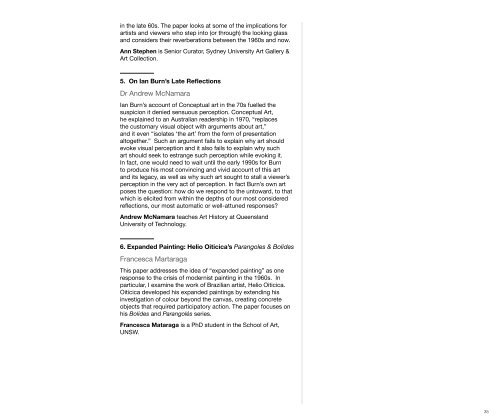2009 AAANZ Conference Abstracts - The Art Association of Australia ...
2009 AAANZ Conference Abstracts - The Art Association of Australia ...
2009 AAANZ Conference Abstracts - The Art Association of Australia ...
You also want an ePaper? Increase the reach of your titles
YUMPU automatically turns print PDFs into web optimized ePapers that Google loves.
in the late 60s. <strong>The</strong> paper looks at some <strong>of</strong> the implications for<br />
artists and viewers who step into (or through) the looking glass<br />
and considers their reverberations between the 1960s and now.<br />
Ann Stephen is Senior Curator, Sydney University <strong>Art</strong> Gallery &<br />
<strong>Art</strong> Collection.<br />
5. On Ian Burn’s Late Reflections<br />
Dr Andrew McNamara<br />
Ian Burn’s account <strong>of</strong> Conceptual art in the 70s fuelled the<br />
suspicion it denied sensuous perception. Conceptual <strong>Art</strong>,<br />
he explained to an <strong>Australia</strong>n readership in 1970, “replaces<br />
the customary visual object with arguments about art,”<br />
and it even “isolates ‘the art’ from the form <strong>of</strong> presentation<br />
altogether.” Such an argument fails to explain why art should<br />
evoke visual perception and it also fails to explain why such<br />
art should seek to estrange such perception while evoking it.<br />
In fact, one would need to wait until the early 1990s for Burn<br />
to produce his most convincing and vivid account <strong>of</strong> this art<br />
and its legacy, as well as why such art sought to stall a viewer’s<br />
perception in the very act <strong>of</strong> perception. In fact Burn’s own art<br />
poses the question: how do we respond to the untoward, to that<br />
which is elicited from within the depths <strong>of</strong> our most considered<br />
reflections, our most automatic or well-attuned responses<br />
Andrew McNamara teaches <strong>Art</strong> History at Queensland<br />
University <strong>of</strong> Technology.<br />
6. Expanded Painting: Helio Oiticica’s Parangoles & Bolides<br />
Francesca Martaraga<br />
This paper addresses the idea <strong>of</strong> “expanded painting” as one<br />
response to the crisis <strong>of</strong> modernist painting in the 1960s. In<br />
particular, I examine the work <strong>of</strong> Brazilian artist, Helio Oiticica.<br />
Oiticica developed his expanded paintings by extending his<br />
investigation <strong>of</strong> colour beyond the canvas, creating concrete<br />
objects that required participatory action. <strong>The</strong> paper focuses on<br />
his Bolides and Parangolés series.<br />
Francesca Mataraga is a PhD student in the School <strong>of</strong> <strong>Art</strong>,<br />
UNSW.<br />
35



